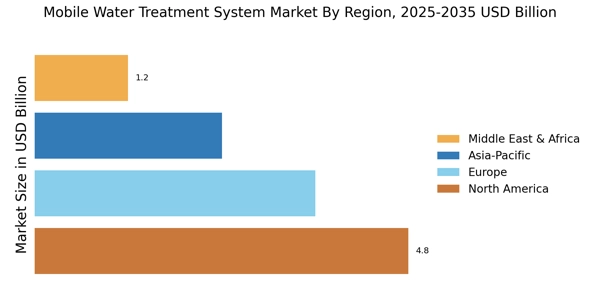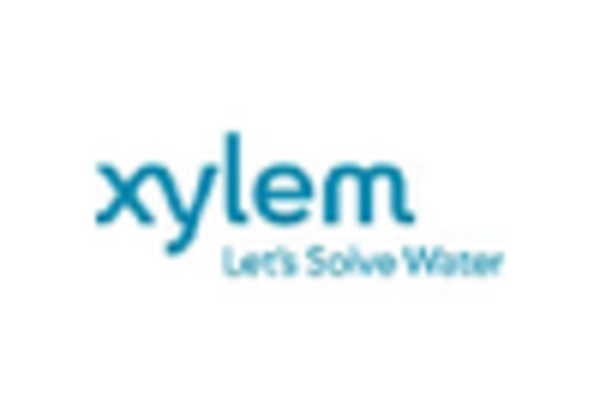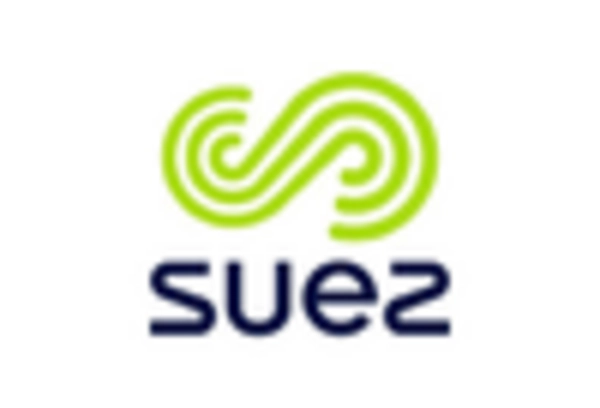Rising Water Scarcity
The increasing prevalence of water scarcity is a critical driver for the Mobile Water Treatment System Market. As populations grow and industrial activities expand, the demand for clean water intensifies. Reports indicate that by 2025, nearly 1.8 billion people will live in areas with absolute water scarcity, necessitating innovative solutions. Mobile water treatment systems offer a flexible and efficient means to address this challenge, providing immediate access to potable water in remote or disaster-stricken areas. This adaptability is particularly valuable in regions where traditional infrastructure is lacking or compromised. Consequently, the urgency to secure water resources propels the growth of the Mobile Water Treatment System Market, as stakeholders seek effective methods to ensure water availability.
Technological Innovations
Technological advancements are significantly influencing the Mobile Water Treatment System Market. Innovations in filtration, disinfection, and purification technologies are enhancing the efficiency and effectiveness of mobile systems. For example, the integration of advanced membrane technologies and real-time monitoring systems allows for improved water quality and operational efficiency. The market is projected to grow at a compound annual growth rate of approximately 8% over the next five years, driven by these technological improvements. As new technologies emerge, they not only enhance the performance of mobile water treatment systems but also reduce operational costs, making them more attractive to a broader range of users, including municipalities and industries.
Regulatory Support and Standards
Government regulations and standards play a pivotal role in shaping the Mobile Water Treatment System Market. Many countries are implementing stringent water quality regulations to safeguard public health and the environment. These regulations often mandate the use of advanced water treatment technologies, thereby driving demand for mobile solutions that can meet these requirements. For instance, the introduction of new guidelines for wastewater treatment has led to an increased focus on mobile systems that can be deployed quickly and efficiently. As regulatory frameworks evolve, the Mobile Water Treatment System Market is likely to experience growth, as companies adapt to comply with these standards and provide innovative solutions that align with regulatory expectations.
Increased Awareness of Water Quality
Growing awareness regarding water quality and its impact on health is a significant driver for the Mobile Water Treatment System Market. Consumers and industries alike are becoming more conscious of the contaminants present in water sources, leading to a heightened demand for effective treatment solutions. This trend is particularly evident in regions facing pollution challenges, where mobile systems can provide immediate remediation. The market is responding to this demand, with an increasing number of companies offering mobile solutions that ensure safe drinking water. As public awareness continues to rise, the Mobile Water Treatment System Market is expected to expand, driven by the need for reliable and efficient water treatment options.
Emergency Response and Disaster Management
The necessity for rapid response in emergency situations is a crucial driver for the Mobile Water Treatment System Market. Natural disasters, industrial accidents, and humanitarian crises often disrupt access to clean water, creating an urgent need for mobile treatment solutions. These systems can be deployed quickly to provide immediate relief, ensuring that affected populations have access to safe drinking water. The market for mobile water treatment systems is likely to grow as governments and organizations recognize the importance of preparedness and response capabilities. Investments in mobile technologies for disaster management are expected to increase, further propelling the Mobile Water Treatment System Market as stakeholders seek to enhance their emergency response strategies.


















Leave a Comment